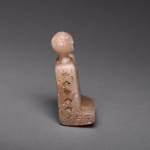Bactria-Margiana Alabaster Idol, 2500 BCE - 1500 BCE
Alabaster
5.7 x 3.2 cm
2 1/4 x 1 1/4 in
2 1/4 x 1 1/4 in
PF.2340
Further images
This piece pertains to an ancient culture referred to both as the Bactria-Margiana Archaeological Complex (BCAM) or as the Oxus Civilisation. The Bactria-Margiana culture spread across an area encompassing the...
This piece pertains to an ancient culture referred to both as the Bactria-Margiana Archaeological Complex (BCAM) or as the Oxus Civilisation. The Bactria-Margiana culture spread across an area encompassing the modern nations of Turkmenistan, Tajikistan, Uzbekistan and Northern Afghanistan. Flourishing between about 2100 and 1700 BC, it was contemporary with the European Bronze Age, and was characterised by monumental architecture, social complexity and extremely distinctive cultural artefacts that vanish from the record a few centuries after they first appear. Pictographs on seals have been argued to indicate an independently-developed writing system.
It was one of many economic and social entities in the vicinity, and was a powerful country due to the exceptional fertility and wealth of its agricultural lands. This in turn gave rise to a complex and multifaceted set of societies with specialist craftsmen who produced luxury materials such as this for the ruling and aristocratic elites. Trade appears to have been important, as Bactrian artefacts appear all over the Persian Gulf as well as in the Iranian Plateau and the Indus Valley. For this reason, the area was fought over from deep prehistory until the Mediaeval period, by the armies of Asia Minor, Greece (Macedonia), India and the Arab States, amongst others.
Religion may have been based around deities represented by pieces such as this. However, they are extremely rare. A 2003 inventory calculated that there were at least thirty-eight examples of such Bactrian idols known, and although the number of examples discovered since has increased, the total number of such Bactrian idols remains relatively small. Nine examples have been found in south-eastern Turkmenistan and two more in Pakistan. Their significance is unclear. Some scholars identify them as elite members of this early society, while others consider their compelling monumentality to signify that these female figures are depictions of one (or more) goddesses.
Recent Carbon 14 dating of the organic material found in association with some of the excavated examples suggests a chronological position for the group in the early second millennium BC about 2000-1800 BC, and the use of different coloured stone is apparently consistent with this dating. The technique appears to be used for the creation of composite figures of approximately the same dimensions excavated at Ebla. As one of less than fifty such examples in the world, this piece has the quality of rarity as well as an intensely powerful presence out of all proportion to its size. In its simplicity and its inherent monumentality, the figure resonates with contemporary aesthetic taste. This is a remarkable and fascinating piece of ancient art, and a credit to any collection fortunate enough to contain it.
It was one of many economic and social entities in the vicinity, and was a powerful country due to the exceptional fertility and wealth of its agricultural lands. This in turn gave rise to a complex and multifaceted set of societies with specialist craftsmen who produced luxury materials such as this for the ruling and aristocratic elites. Trade appears to have been important, as Bactrian artefacts appear all over the Persian Gulf as well as in the Iranian Plateau and the Indus Valley. For this reason, the area was fought over from deep prehistory until the Mediaeval period, by the armies of Asia Minor, Greece (Macedonia), India and the Arab States, amongst others.
Religion may have been based around deities represented by pieces such as this. However, they are extremely rare. A 2003 inventory calculated that there were at least thirty-eight examples of such Bactrian idols known, and although the number of examples discovered since has increased, the total number of such Bactrian idols remains relatively small. Nine examples have been found in south-eastern Turkmenistan and two more in Pakistan. Their significance is unclear. Some scholars identify them as elite members of this early society, while others consider their compelling monumentality to signify that these female figures are depictions of one (or more) goddesses.
Recent Carbon 14 dating of the organic material found in association with some of the excavated examples suggests a chronological position for the group in the early second millennium BC about 2000-1800 BC, and the use of different coloured stone is apparently consistent with this dating. The technique appears to be used for the creation of composite figures of approximately the same dimensions excavated at Ebla. As one of less than fifty such examples in the world, this piece has the quality of rarity as well as an intensely powerful presence out of all proportion to its size. In its simplicity and its inherent monumentality, the figure resonates with contemporary aesthetic taste. This is a remarkable and fascinating piece of ancient art, and a credit to any collection fortunate enough to contain it.





